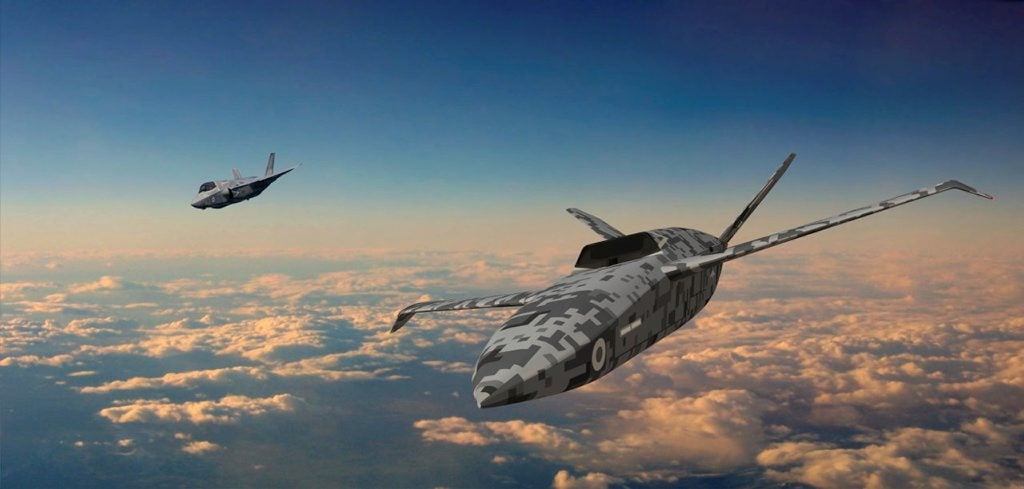
Mosquito is the RAF’s name for a programme to build the UK’s first uncrewed fighter aircraft, able to target and shoot down adversaries aircraft. The project is currently being led by Spirit AeroSystems with an aim for full-scale flight tests in 2023.
Mosquito is designed to fill the role of a ‘Loyal Wingman’ flying alongside crewed fighter jets, increasing combat mass at a lower cost.
Commenting on the future mix of aircraft, Carter told the IISS thinktank: “I think by 2030, it’s entirely respectable for us to posit a view that a tactical formation in the Air Force will move from being eight Typhoon to being two Typhoon, 10 Mosquitoes and 100 Alvino, because that is another way of generating significant mass, and you can see that playing out both in the land and maritime domains as well.”
Alvina is to be a swarming drone platform and was mentioned by the Chief of the Air Staff Air Chief Marshal Sir Mike Wigston at the Royal United Services Institute Lord Trenchard Memorial Lecture earlier this year.
Speaking at the RUSI event earlier this year, Wigston described the future Royal Air Force as being made up of Tempest, F-35, Mosquito, Alvina, and Protector remotely piloted air system (RPAS) and 80% uncrewed or remotely piloted.
Carter added: “That implies that we’re talking in sunrise [upcoming capabilities] terms of being more dispensable, cheaper and less exquisite. And of course, this has got to be integrated into ever more sophisticated networks and systems to avoid that single point of failure, and to make the network spark up.”

US Tariffs are shifting - will you react or anticipate?
Don’t let policy changes catch you off guard. Stay proactive with real-time data and expert analysis.
By GlobalDataRoyal United Services Institute (RUSI) research fellow and editor of RUSI Defence Systems Justin Bronk told Air Force Technology the target of an 80% uncrewed force would rely on these systems being supplemental to crewed assets until 2035 at the earliest.
Bronk explained: “The military needs to be able to guarantee operational effectiveness despite a contested or denied electromagnetic spectrum, which means uncrewed systems will have to be able to automatically perform their missions during periods of denied remote human oversight.
“This either means high levels of autonomous capacity or restricting uncrewed systems to mission sets short of serious state-on-state conflict.”
Bronk said both of these approaches meant replacing 80% of the existing RAF force would be difficult in the foreseeable future but added that ‘both approaches could still generate very useful supplementary capabilities for specific scenarios alongside existing types.’
Commenting on the deployment of swarming munitions and UAVs, Bronk said that if they were to deploy on masse they would need to be ‘fairly cheap’, however, this also means the systems would need to be small. This small factor however means that the systems would also have shorter ranges.
Bronk added that delivering something like Alvina to a target area is a ‘non-trivial’ problem.
“If it is to be dropped from transport aircraft or launched from ships then it must have a range sufficient to allow those platforms to stay a safe distance from high threat adversary systems,” Bronk said.
In the US, under its Gremlins programme, the Defense Advanced Research Projects Agency (DARPA) is testing deploying and catching UAVs with the C-130 Hercules aircraft. A similar feat could be achieved in principle with the Royal Air Forces A-400M transport aircraft.
Bronk said that in order for Alvina to be deployed from a transport aircraft or launched from a ship at a safe distance, the UAV would likely need to be the size of a cruise missile, making it more expensive and reducing ‘affordable numbers’.
“However, if they are smaller and cheaper, they will need to be delivered much closer to the enemy and thus will compete directly with other weapons, effectors for limited payload capacity on survivable assets like Typhoon or F-35” Bronk added.



